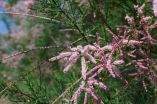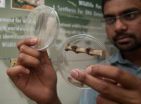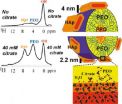(Press-News.org) Jellyfish can be a nuisance to bathers and boaters in the Chesapeake Bay on the United States' East Coast and many other places along the world's coasts.
A new study by researchers at the Virginia Institute of Marine Science (VIMS) shows that jellyfish also have a more significant impact, drastically altering marine food webs by shunting food energy toward bacteria.
An apparent increase in the size and frequency of jellyfish blooms in coastal and estuarine waters around the world during the last few decades means that jellies' impact on marine food webs is likely to increase in the future.
The results of the study, led by recent VIMS graduate Rob Condon--now a scientist at the Dauphin Island Sea Lab (DISL) in Alabama--appear in this week's issue of the journal Proceedings of the National Academy of Sciences.
His co-authors are VIMS scientists Deborah Steinberg and Deborah Bronk, Paul del Giorgio of the Université du Québec à Montréal, Thierry Bouvier of Université Montpellier in France, Monty Graham of DISL and Hugh Ducklow of the Marine Biological Laboratory in Woods Hole, Massachusetts.
The research was funded by the National Science Foundation (NSF).
"This intriguing finding demonstrates that changes at the top of the food web can affect even the most fundamental ecosystem processes," says David Garrison, director of NSF's Biological Oceanography Program.
Condon conducted his field studies by sampling jellyfish blooms in the York River, a tributary of lower Chesapeake Bay.
The team's experimental work took place in laboratories at VIMS, and in Canada and France.
The researchers tracked the flow of food energy in the lab by measuring the amount of carbon taken up and released by jellyfish and bacteria within closed containers during "incubation" experiments of varying length. Carbon is the "currency" of energy exchange in living systems.
"Jellyfish are voracious predators," says Condon. "They affect food webs by capturing plankton that would otherwise be eaten by fish, and converting that food energy into gelatinous biomass. This restricts the transfer of energy up the food chain, because jellyfish are not readily consumed by other predators."
Jellyfish also shunt food energy away from fish and shellfish that humans like to eat through their effects on the bacterial community.
"Marine bacteria typically play a key role in recycling carbon, nitrogen, phosphorus and other by-products of organic decay back into the food web," says Condon.
"But in our study, we found that when bacteria consumed dissolved organic matter from jellyfish they shunted it toward respiration rather than growth."
The upshot of this "jelly carbon shunt" is that bacteria in jelly-laden waters end up
converting carbon back to carbon dioxide, rather than using it to grow larger or reproduce.
This means the carbon is lost as a direct source of organic energy for transfer up the food web.
The researchers think the shift toward bacterial respiration happens because jellyfish produce organic matter that is extra-rich in carbon.
They do so through excretion and the sloughing of mucus. "The mucus is the slime you feel when you pick up a jelly," says Steinberg.
The jellyfish in Condon's experiments released large quantities of carbon-rich organic matter--with 25- to 30-times more carbon than nitrogen.
That compares to a ratio of 6 parts carbon to 1 part nitrogen for the organic matter found dissolved in typical marine waters.
"The bacteria metabolized this carbon-rich material two to six times faster than they did with dissolved organic matter from water without jellyfish," says Condon.
"This rapid metabolism shunted carbon toward respiration rather than production, reducing their potential to assimilate this material by 10 to 15 percent."
Steinberg says that bacterial metabolism of dissolved organic matter from jellyfish is like "drinking Gatorade," while metabolism of dissolved organic matter from phytoplankton and other sources is like "eating a hamburger. It just doesn't provide an efficient food source for marine bacteria."
A final significant finding from the team's research is that an influx of dissolved organic matter from jellyfish blooms changes the make-up of the local microbial community.
"Dissolved organic matter [DOM] from jellyfish favored the rapid growth and dominance of specific bacterial groups that were otherwise rare in the York River," says Condon.
"This implies that jelly-DOM was channeled through a small component of the local microbial assemblage and thus induced large changes in community composition."
Overall, says Condon, the team's findings "suggest major shifts in microbial structure and function associated with jellyfish blooms, and a large detour of energy toward bacteria and away from higher trophic levels."
He adds that a host of factors, including climate change, over-harvesting of fish, fertilizer runoff and habitat modifications could help to fuel jellyfish blooms into the future.
"Indeed," he says, "we've seen this already in Chesapeake Bay. If these swarms continue to emerge, we could see a substantial biogeochemical impact on our ecosystems."
"Simply knowing how carbon is processed by phytoplankton, zooplankton, microbes or other trophic levels in space and time can lead to estimates of how much carbon energy is available for fish to consume," he says.
"The more we know, the better we can manage ecosystem resources."
INFORMATION:
Jellyfish blooms transfer food energy from fish to bacteria
Impact on ocean food webs likely to increase in the future
2011-06-09
ELSE PRESS RELEASES FROM THIS DATE:
Penn researchers develop biological circuit components, new microscope technique for measuring them
2011-06-09
PHILADELPHIA — Electrical engineers have long been toying with the idea of designing biological molecules that can be directly integrated into electronic circuits. University of Pennsylvania researchers have developed a way to form these structures so they can operate in open-air environments, and, more important, have developed a new microscope technique that can measure the electrical properties of these and similar devices.
The research was conducted by Dawn Bonnell, Trustee Chair Professor and director of the Nano/Bio Interface Center, graduate students Kendra Kathan-Galipeau ...
New 3-D tumor model
2011-06-09
College Park, Md. (June 08, 2011) – A team of scientists has developed a way to coax tumor cells in the lab to grow into 3-D spheres. Their discovery takes advantage of an earlier technique of producing spherical cavities in a common polymer and promises more accurate tests of new cancer therapies.
As team leader Michael R. King, Ph.D., of Cornell University explains, "Sometimes engineering research tends to be a case of a hammer looking for a nail. We knew our previous discovery was new and it was cool. And now we know it's useful."
Three years ago, the team -- in ...
Ecology biased against non-native species?
2011-06-09
The recent field of invasion biology faces a new challenge as 19 eminent ecologists issue a call to "end the bias against non-native species" in the journal Nature.
Often called aliens, hitchhikers or invasives, some scientists say that non-native species could just as easily be coined "abductees" whose transport links to activities by humans.
The authors of the Nature comments section note that assumptions that "introduced species" offer only deleterious impacts are misguided and "that human-induced impacts, such as climate change, nitrogen eutrophication, urbanization ...
Saving wildlife with forensic genetics
2011-06-09
Wildlife face many threats with spreading urbanization, including habitat loss and inbreeding when populations become fragmented and isolated. It doesn't help that there is a billion-dollar international industry dedicated to the illegal trafficking of wild animals or wild animal parts.
The Conservation Genetics Lab at the University of Arizona is working to conserve and protect wild animals around the world.
"Our work here deals with using genetics for wildlife conservation," said Ashwin Naidu, a doctoral candidate in the School of Natural Resources and the Environment.
One ...
Researchers discover superatoms with magnetic shells
2011-06-09
RICHMOND, Va. (June 8, 2011) – A team of Virginia Commonwealth University scientists has discovered a new class of 'superatoms' – a stable cluster of atoms that can mimic different elements of the periodic table – with unusual magnetic characteristics.
The superatom contains magnetized magnesium atoms, an element traditionally considered as non-magnetic. The metallic character of magnesium along with infused magnetism may one day be used to create molecular electronic devices for the next generation of faster processors, larger memory storage and quantum computers.
In ...
Lifelong gap in health between rich and poor set by age 20
2011-06-09
"We can't buy our way out of ageing," says Nancy Ross, a McGill geography professor. "As we get older we start to have vision problems, maybe some hearing loss, maybe lose some mobility – ageing is a kind of a social equalizer."
Ross is the lead author of a new study about how socio-economic and educational status affects Canadians' health-related quality of life over the course of a lifetime.
"My research looks at how poverty and social disadvantage affect your health status. Our work was about using social circumstances as a lens to look at how people's quality ...
Citrate key in bone's nanostructure
2011-06-09
AMES, Iowa - Bone is one of nature's surprising "building materials." Pound-for-pound it's stronger than steel, tough yet resilient. Scientists at the U.S. Department of Energy's Ames Laboratory have identified the composition that gives bone its outstanding properties and the important role citrate plays, work that may help science better understand and treat or prevent bone diseases such as osteoporosis.
Using nuclear magnetic resonance (NMR) spectroscopy, Ames Laboratory scientist and Iowa State University chemistry professor Klaus Schmidt-Rohr and his colleagues ...
Will psych majors make the big bucks?
2011-06-09
A new crop of college graduates have just landed on the job market. Right now they're probably just hoping to get any job, if at all. However, for psychology majors, the salary outlook in both the short and long term is particularly poor, according to a new study which will be published in an upcoming issue of Perspectives on Psychological Science, a journal of the Association for Psychological Science.
It's generally known that psychology majors don't make a ton of money when they're starting out; they're not like engineering students, many of whom go straight into a ...
How cells' sensing hairs are made
2011-06-09
Body cells detect signals that control their behavior through tiny hairs on the cell surface called cilia. Serious diseases and disorders can result when these cilia do not work properly. New research from UC Davis published this week in the journal Nature Cell Biology provides new insights into how these cilia are assembled.
"It's a basic discovery, but with implications for understanding disease," said Jonathan Scholey, professor of molecular and cellular biology at UC Davis and senior author of the study. Understanding how cilia are assembled and function can help ...
'Thermal pollution' in rivers not fully mediated by gravel augmentation
2011-06-09
Although adding gravel to a river to replace lost sediments won't likely cool the whole river channel, it can create cool water refuges that protect fish from thermal pollution, according to a U.S. Forest Service Pacific Northwest Research Station study.
The research—featured in the June 2011 issue of Science Findings, a monthly publication of the station—is among the first to explore the interplay between sub-surface water flow and temperature in large rivers and is helping to guide river restoration strategies in the Pacific Northwest.
In the study, which began ...
LAST 30 PRESS RELEASES:
Study links genetic variants to risk of blinding eye disease in premature infants
Non-opioid ‘pain sponge’ therapy halts cartilage degeneration and relieves chronic pain
AI can pick up cultural values by mimicking how kids learn
China’s ecological redlines offer fast track to 30 x 30 global conservation goal
Invisible indoor threats: emerging household contaminants and their growing risks to human health
Adding antibody treatment to chemo boosts outcomes for children with rare cancer
Germline pathogenic variants among women without a history of breast cancer
Tanning beds triple melanoma risk, potentially causing broad DNA damage
Unique bond identified as key to viral infection speed
Indoor tanning makes youthful skin much older on a genetic level
Mouse model sheds new light on the causes and potential solutions to human GI problems linked to muscular dystrophy
The Journal of Nuclear Medicine ahead-of-print tip sheet: December 12, 2025
Smarter tools for peering into the microscopic world
Applications open for funding to conduct research in the Kinsey Institute archives
Global measure underestimates the severity of food insecurity
Child survivors of critical illness are missing out on timely follow up care
Risk-based vs annual breast cancer screening / the WISDOM randomized clinical trial
University of Toronto launches Electric Vehicle Innovation Ontario to accelerate advanced EV technologies and build Canada’s innovation advantage
Early relapse predicts poor outcomes in aggressive blood cancer
American College of Lifestyle Medicine applauds two CMS models aligned with lifestyle medicine practice and reimbursement
Clinical trial finds cannabis use not a barrier to quitting nicotine vaping
Supplemental nutrition assistance program policies and food insecurity
Switching immune cells to “night mode” could limit damage after a heart attack, study suggests
URI-based Global RIghts Project report spotlights continued troubling trends in worldwide inhumane treatment
Neutrophils are less aggressive at night, explaining why nighttime heart attacks cause less damage than daytime events
Menopausal hormone therapy may not pose breast cancer risk for women with BRCA mutations
Mobile health tool may improve quality of life for adolescent and young adult breast cancer survivors
Acupuncture may help improve perceived breast cancer-related cognitive difficulties over usual care
Nerve block may reduce opioid use in infants undergoing cleft palate surgery
CRISPR primes goldenberry for fruit bowl fame
[Press-News.org] Jellyfish blooms transfer food energy from fish to bacteriaImpact on ocean food webs likely to increase in the future



